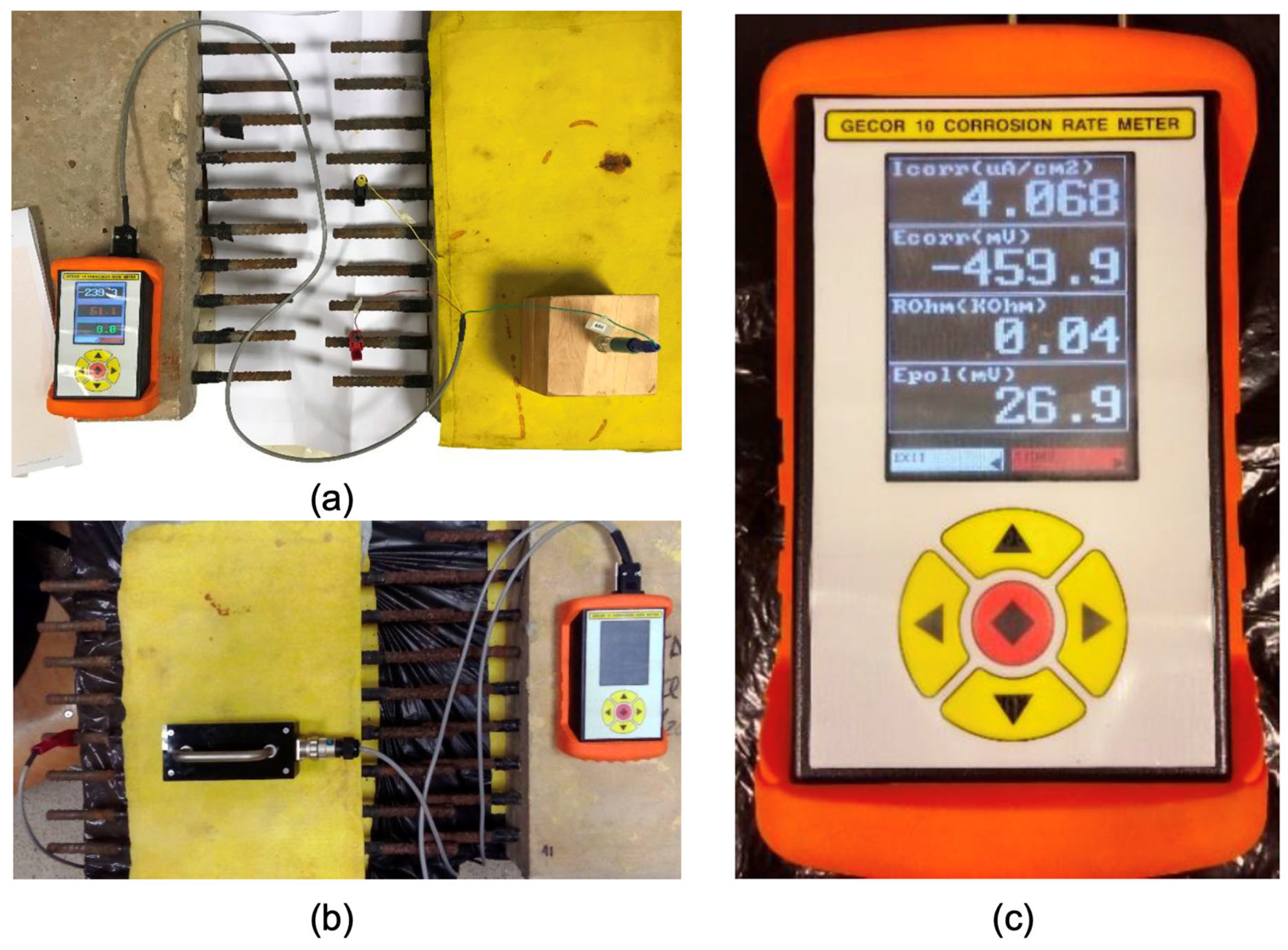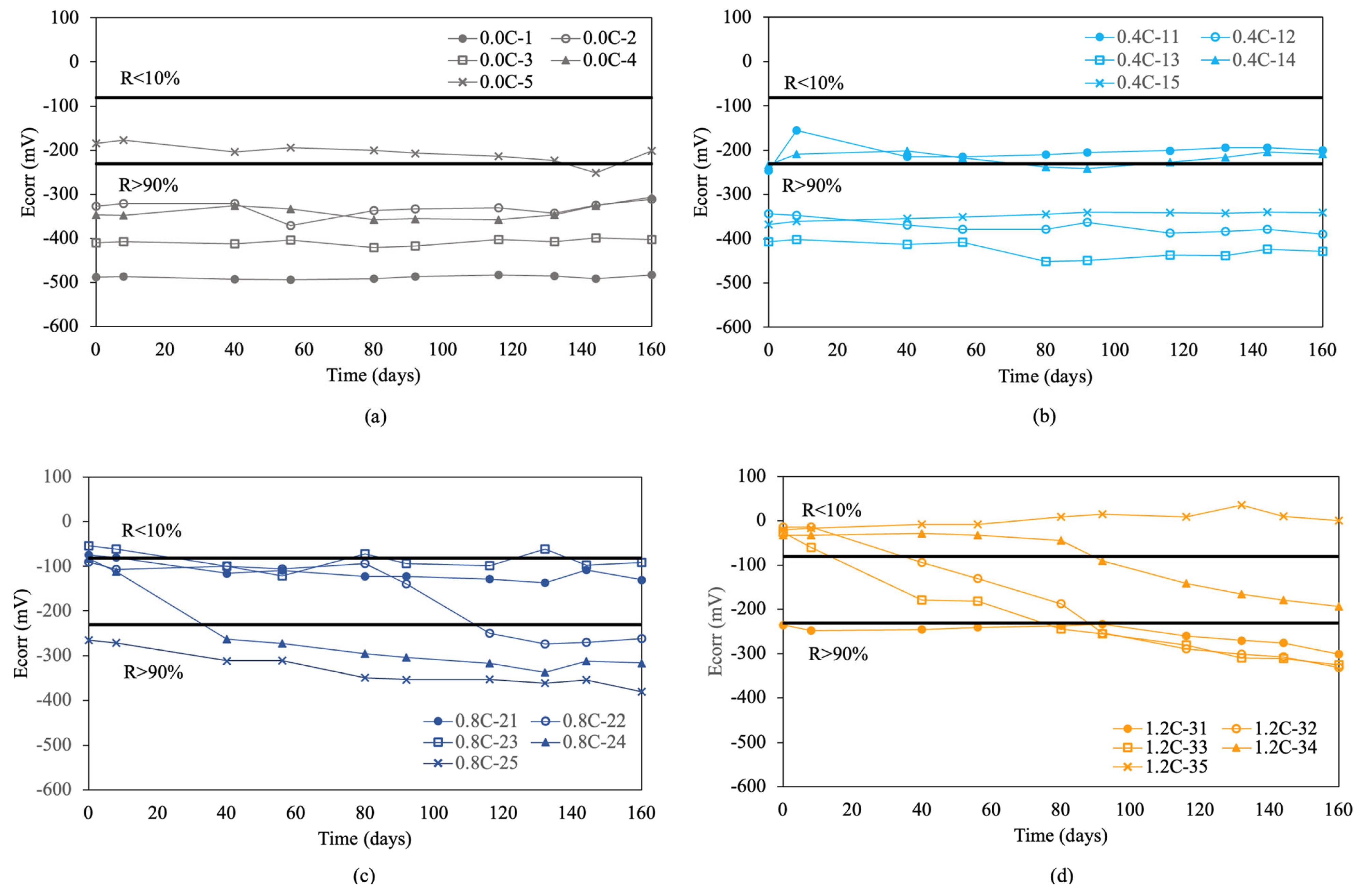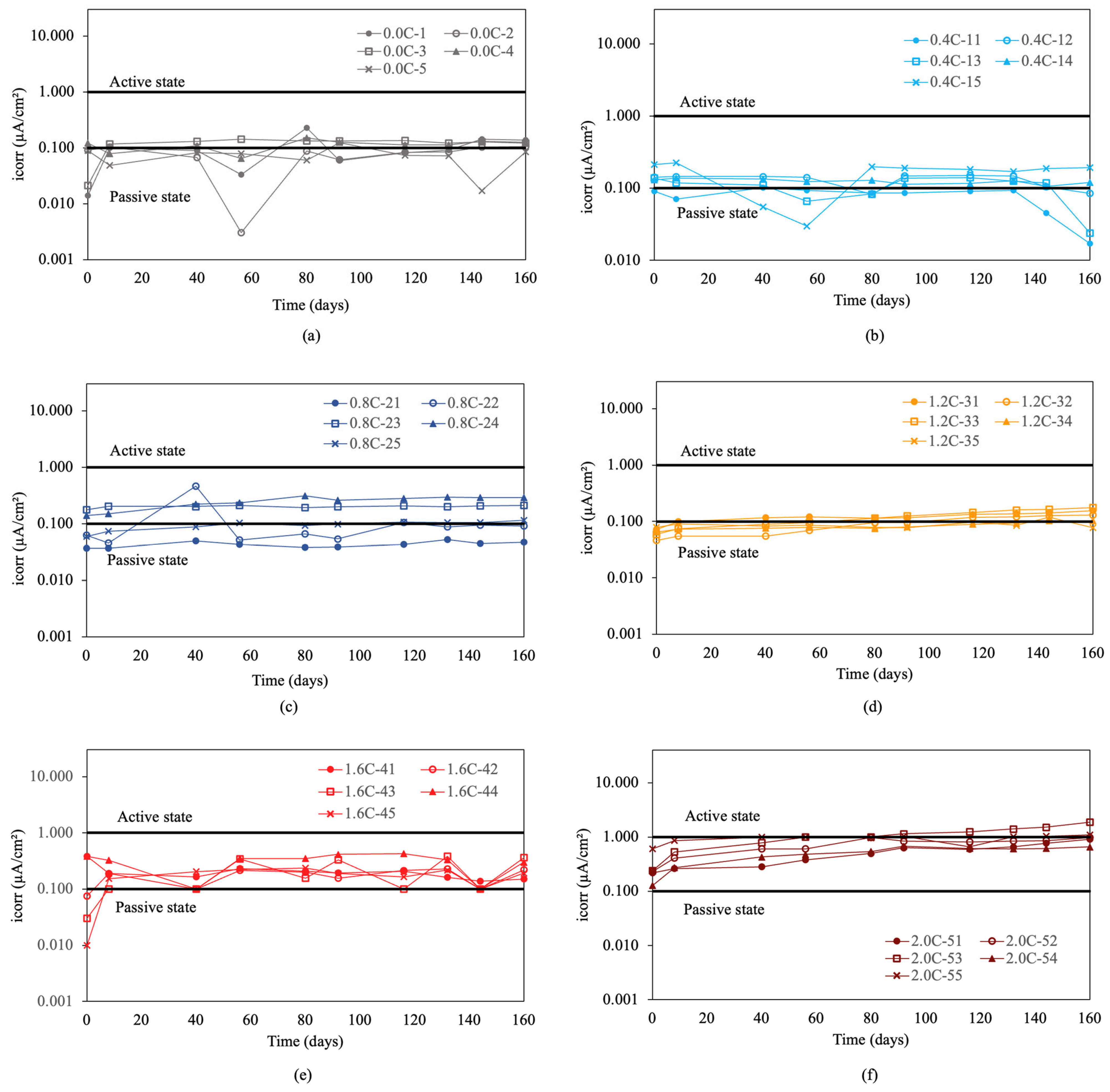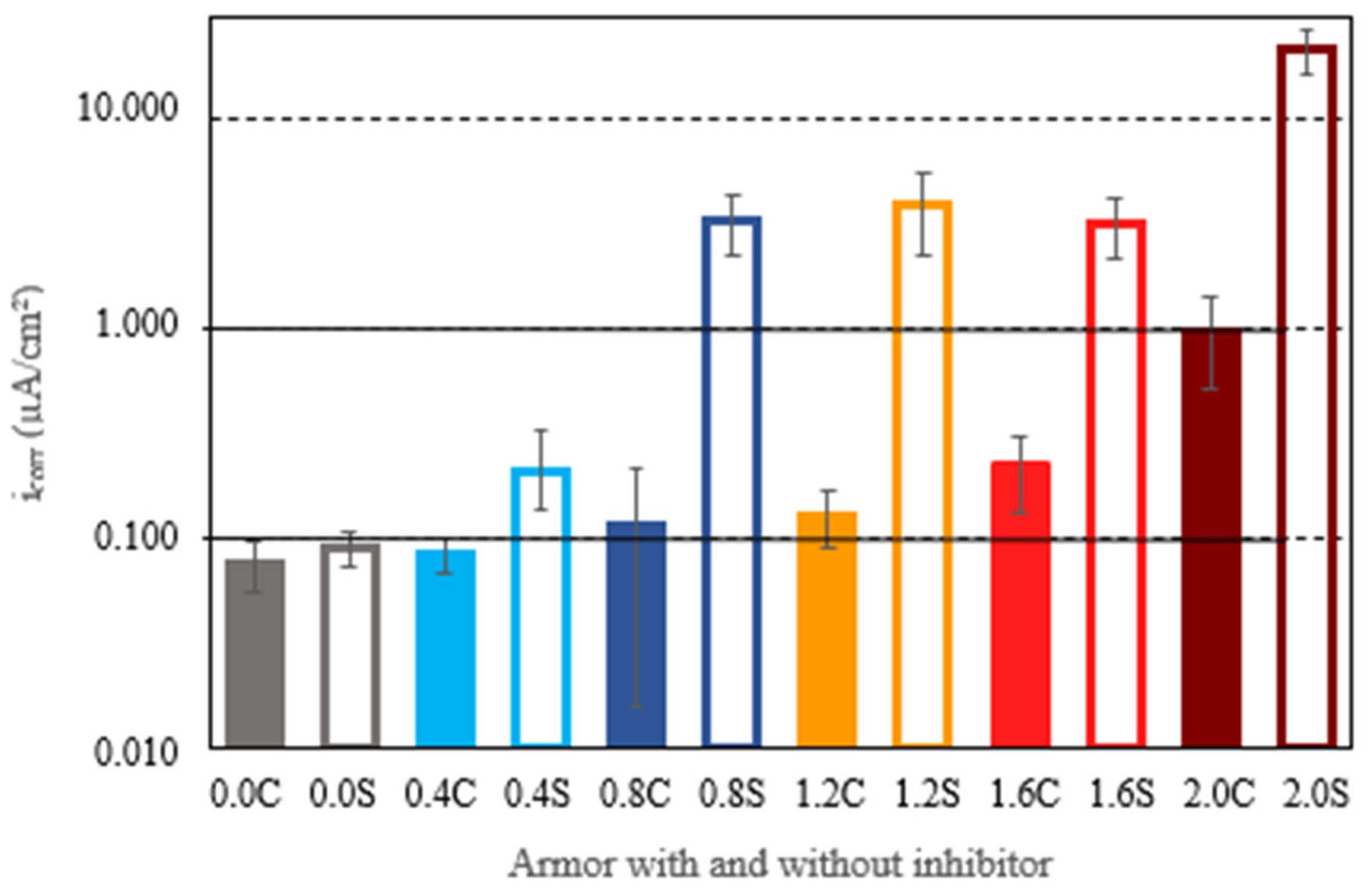Analysis of the Effectiveness of the Application of Corrosion Inhibitors to Steel Re-Bars Embedded in Concrete
Abstract
1. Introduction
2. Methodology
2.1. Materials Used
2.2. Preparation of the Specimens
2.3. Measurement
3. Results and Discussion
3.1. Corrosion Potential (Ecorr) Results
3.2. Corrosion Rate Results (icorr) in Re-Bars with and without Inhibitor, Incorporated into Concretes with Different Percentages of Chloride Ion
3.3. Relationship between Icorr and Ecorr in Armored Structures with and without Inhibitor
3.4. Statistical Analysis of icorr and Ecorr in Re-Bars with and without Inhibitor
4. Conclusions
- Reinforcement bars without inhibitor reach corrosion speeds typical of the active state for chloride ion percentages equal to or greater than 0.8%. In reinforcement bars with inhibitor, a chloride ion percentage of 2.0% in the concrete is necessary for the reinforcement bars to reach corrosion values typical of the active state.
- In all cases, the presence of corrosion inhibitor significantly reduces the corrosion speed achieved by the reinforcement bars.
- The correlation between corrosion potential measurements and corrosion speed is only consistent in reinforcement bars without inhibitor.
- Corrosion potential measurements taken in isolation in structures with reinforcement bars with inhibitor are not indicative of the steel corrosion state.
- The direct application of inhibitors on the reinforcement bars emerges as a viable strategy, both for new constructions and rehabilitation, being particularly effective in concretes with chloride ion percentages between 0.8% and 1.6%, where their application reduces the corrosion speed to low levels, increasing the lifespan of the structures.
Author Contributions
Funding
Institutional Review Board Statement
Informed Consent Statement
Data Availability Statement
Conflicts of Interest
References
- Prieto Barrio, M.I. Análisis del Comportamiento a Corrosión de Armaduras Embebidas en Probetas de Mortero. Con Sustitución Parcial de Áridos y Cemento por Escorias Blancas de Horno Cuchara. Ph.D. Thesis, Arquitectura_Tecnica, Escuela Universitaria de Arquitectura Técnica, La Coruña, Spain, 2012. [Google Scholar]
- Al-Amoudi, O.S.B.; Maslehuddin, M.; Lashari, A.N.; Almusallam, A.A. Effectiveness of corrosion inhibitors in contaminated concrete. Cem. Concr. Compos. 2003, 25, 439–449. [Google Scholar] [CrossRef]
- Tiwari, A.K.; Purnima; Goyal, S.; Luxami, V. Influence of corrosion inhibitors on two different concrete systems under combined chloride and carbonated environment. Structures 2023, 48, 717–735. [Google Scholar] [CrossRef]
- Tian, Y.; Bao, J.; Xie, D.; Wang, B.; Zhang, P.; Zhao, T.; Lei, D. The effects of organic corrosion inhibitor on concrete properties and frost resistance. J. Build. Eng. 2023, 65, 105762. [Google Scholar] [CrossRef]
- Medina, E. Construcción de Estructuras de Hormigón Armado; Bellisco Ediciones: Madrid, Spain, 2009. [Google Scholar]
- Aguirre, A.M.; De Gutiérrez, R.M. Durabilidad del hormigón armado expuesto a condiciones agresivas. Mater. Construcción 2013, 63, 7–38. [Google Scholar] [CrossRef]
- BOE-A-2021-13681 Real Decreto 470/2021. de 29 de Junio. Por el que se Aprueba el Código Estructural. (s. f.); Ministerio de la Presidencia: Madrid, Spain, 2021.
- Wang, H.; Zhang, A.; Zhang, L.; Liu, J.; Yan, H.; Shu, H.; Wang, J. Study on the influence of compound rust inhibitor on corrosion of steel bars in chloride concrete by electrical parameters. Constr. Build. Mater. 2020, 262, 120763. [Google Scholar] [CrossRef]
- Balaji, C.R.; De Azevedo, A.R.G.; Madurwar, M.V. Sustainable perspective of ancillary construction materials in infrastructure industry: An overview. J. Clean. Prod. 2022, 365, 132864. [Google Scholar] [CrossRef]
- Maury-Ramírez, A.; De Belie, N. Environmental and Economic Assessment of Eco-Concrete for Residential Buildings: A Case Study of Santiago de Cali (Colombia). Sustainability 2023, 15, 12032. [Google Scholar] [CrossRef]
- Da Silva, S.R.; De Oliveira Andrade, J.J. A Review on the Effect of Mechanical Properties and Durability of Concrete with Construction and Demolition Waste (CDW) and Fly Ash in the Production of New Cement Concrete. Sustainability 2022, 14, 6740. [Google Scholar] [CrossRef]
- Saleem, H.; Zaidi, S.J.; Al-Nuaimi, N. Recent Advancements in the Nanomaterial Application in Concrete and Its Ecological Impact. Materials 2021, 14, 6387. [Google Scholar] [CrossRef]
- James, A.; Bazarchi, E.; Chiniforush, A.A.; Aghdam, P.P.; Hosseini, M.R.; Akbarnezhad, A.; Martek, I.; Ghodoosi, F. Rebar corrosion detection. protection. and rehabilitation of reinforced concrete structures in coastal environments: A review. Constr. Build. Mater. 2019, 224, 1026–1039. [Google Scholar] [CrossRef]
- Wittocx, L.; Buyle, M.; Audenaert, A.; Seuntjens, O.; Renne, N.; Craeye, B. Revamping corrosion damaged reinforced concrete balconies: Life cycle assessment and life cycle cost of life-extending repair methods. J. Build. Eng. 2022, 52, 104436. [Google Scholar] [CrossRef]
- Gandía-Romero, J.M. Sensores Electroquímicos Aplicados al Estudio de la Corrosión en Estructuras de Hormigón Armado. Ph.D. Thesis, Universitat Politècnica de València, Valencia, Spain, 2015. [Google Scholar] [CrossRef][Green Version]
- Crişan, M.; Muntean, C.; Chumakov, Y.; Pleşu, N. Investigating the Corrosion Inhibition Mechanisms of Alkanolammonium Salts: A Case Study with Ethylethanolammonium 4-Nitrobenzoate on Carbon Steel in Saline Solution. Appl. Sci. 2024, 14, 1832. [Google Scholar] [CrossRef]
- Bonilla Mieles, A.F. Efectividad de los Inhihidores de Corrosión en el Hormigón Armado; Universidad Politécnica de Madrid: Madrid, Spain, 2023. [Google Scholar]
- Bellal, Y.; Benghanem, F.; Keraghel, S. A new corrosion inhibitor for steel rebar in concrete: Synthesis. electrochemical and theoretical studies. J. Mol. Struct. 2021, 1225, 129257. [Google Scholar] [CrossRef]
- Wei, A.; Tan, M.Y.; Koay, Y.C.; Hu, X.; Al-Ameri, R. Effect of carbon fiber waste on steel corrosion of reinforced concrete structures exposed to the marine environment. J. Clean. Prod. 2021, 316, 128356. [Google Scholar] [CrossRef]
- Qu, L.; Wang, Q.; Xu, S.; Wang, N.; Shi, Z. Chloride corrosion resistance of double-layer anticorrosive coating in simulated concrete pore solution. Constr. Build. Mater. 2021, 295, 123682. [Google Scholar] [CrossRef]
- Deza, A. Análisis del Comportamiento Frente a la Corrosión del Acero Embebido en Hormigón en Ambiente Marino. Ph.D. Thesis, E.T.S.I. Navales (UPM), Madrid, Spain, 2017. [Google Scholar] [CrossRef]
- Tuutti, K. Corrosion of Steel in Concrete. Ph.D. Thesis, Swedish Cement and Concrete Research Institute, Stockholm, Sweden, 1982. [Google Scholar]
- Rodrigues, R.; Gaboreau, S.; Gance, J.; Ignatiadis, I.; Betelu, S. Reinforced concrete structures: A review of corrosion mechanisms and advances in electrical methods for corrosion monitoring. Constr. Build. Mater. 2021, 269, 121240. [Google Scholar] [CrossRef]
- Bolzoni, F.; Brenna, A.; Ormellese, M. Recent advances in the use of inhibitors to prevent chloride-induced corrosion in reinforced concrete. Cem. Concr. Res. 2022, 154, 106719. [Google Scholar] [CrossRef]
- Khalid, M.A.; Miyazato, S.; Mizuguchi, H.; Miyaguchi, K. Performance Evaluation of Lithium Nitrite-Based Gel against Corrosion of Rebar with Partial Short Cover Depth in Chloride Environment. Eng. Proc. 2023, 55, 35. [Google Scholar] [CrossRef]
- González-Parra, J.R.; Di Turo, F. The Use of Plant Extracts as Sustainable Corrosion Inhibitors for Cultural Heritage Alloys: A Mini-Review. Sustainability 2024, 16, 1868. [Google Scholar] [CrossRef]
- Zhang, Y.; Ayyub, B.M.; Fung, J.F. Projections of corrosion and deterioration of infrastructure in United States coasts under a changing climate. Resilient Cities Struct. 2022, 1, 98–109. [Google Scholar] [CrossRef]
- Anterrieu, O.; Giroux, B.; Gloaguen, E.; Carde, C. Non-destructive data assimilation as a tool to diagnose corrosion rate in reinforced concrete structures. J. Build. Eng. 2019, 23, 193–206. [Google Scholar] [CrossRef]
- Bouteiller, V.; Tissier, Y.; Marie-Vic, E.; Chaussadent, T.; Joiret, S. The application of electrochemical chloride extraction to reinforced concrete—A review. Constr. Build. Mater. 2022, 351, 128931. [Google Scholar] [CrossRef]
- Carmona, J.; Garcés, P.; Climent, M. Efficiency of a conductive cement-based anodic system for the application of cathodic protection. cathodic prevention and electrochemical chloride extraction to control corrosion in reinforced concrete structures. Corros. Sci. 2015, 96, 102–111. [Google Scholar] [CrossRef]
- Helene, P.R.; Pereira, F. Manual de Rehabilitación de Estructuras de Hormigón Reparación, Refuerzo y Protección; Ciencia y Tecnología para Desarrollo: Buenos Aires, Argentina, 2003. [Google Scholar]
- Liu, Y.; Ding, W.; Zhao, P.; Qin, L.; Shiotani, T. Research on in-situ corrosion process monitoring and evaluation of reinforced concrete via ultrasonic guided waves. Constr. Build. Mater. 2022, 321, 126317. [Google Scholar] [CrossRef]
- Andrade, C. Steel corrosion rates in concrete in contact to sea water. Cem. Concr. Res. 2023, 165, 107085. [Google Scholar] [CrossRef]
- Suárez Quintero, J.A. Evaluación de Inhibidores de Corrosión Aplicados en la Industria Mediante Pruebas Electroquímicas. Ph.D. Thesis, Universidad Pedagógica y Tecnológica de Colombia, Tunja, Colombia, 2018. [Google Scholar]
- Al-Akhras, N.M.; Mashaqbeh, Y. Potential use of eucalyptus leaves as green corrosion inhibitor of steel reinforcement. J. Build. Eng. 2021, 35, 101848. [Google Scholar] [CrossRef]
- Coppola, L.; Beretta, S.; Bignozzi, M.C.; Bolzoni, F.; Brenna, A.; Cabrini, M.; Candamano, S.; Caputo, D.; Carsana, M.; Cioffi, R.; et al. The Improvement of Durability of Reinforced Concretes for Sustainable Structures: A Review on Different Approaches. Materials 2023, 15, 2728. [Google Scholar] [CrossRef] [PubMed]
- Tsouli, S.; Nikolaidis, C.; Kleftakis, S.; Lekatou, A.G. The Effect of pH and Fly Ash on the Electrochemical Performance of Stainless-Steel Concrete Reinforcement in Harsh Environments. Mater. Proc. 2021, 6, 25. [Google Scholar] [CrossRef]
- Bijapur, K.; Vandana, M.; Shetty, A.; Toghan, A.; De Padova, P.; Hegde, G. Recent Trends and Progress in Corrosion Inhibitors and Electrochemical Evaluation. Appl. Sci. 2023, 13, 10107. [Google Scholar] [CrossRef]
- Martín, D.; Seyhan, E.C. Protection of Reinforced Concrete Steel Exposed to a Marine Environment: A Preliminary Onsite Study of the Performance of a New Generation of Surface-Applied Corrosion Inhibitors. Corros. Mater. Degrad. 2022, 3, 628–645. [Google Scholar] [CrossRef]
- Chaudhari, B.; Panda, B.; Šavija, B.; Paul, S.C. Microbiologically Induced Concrete Corrosion: A Concise Review of Assessment Methods, Effects, and Corrosion-Resistant Coating Materials. Materials 2022, 15, 4279. [Google Scholar] [CrossRef] [PubMed]
- Batis, G.; Routoulas, A.; Rakanta, E. Effects of migrating inhibitors on corrosion of reinforcing steel covered with repair mortar. Cem. Concr. Compos. 2003, 25, 109–115. [Google Scholar] [CrossRef]
- Al-Tholaia, M.M.H.; Azad, A.K.; Ahmad, S.; Baluch, M.H. A comparative study of corrosion resistance of different coatings for mortar–embedded steel plates. Constr. Build. Mater. 2014, 56, 74–80. [Google Scholar] [CrossRef]
- Fernández Cánovas, M.; Gálvez Ruiz, J.; Goicolea Marin, P. Estudio del comportamiento mecánico y frente a corrosión de armaduras pasivas de acero revestidas con resina epoxi. Hormigón Acero 2010, 61, 91–104. [Google Scholar]
- Wang, Y.; Wang, C.; Zhou, S.; Liu, K. Influence of cationic epoxy resin type on electrophoretic deposition effect on repair of rust-cracked reinforced concrete. Constr. Build. Mater. 2022, 324, 126714. [Google Scholar] [CrossRef]
- De Domenico, D.; Messina, D.; Recupero, A. Seismic vulnerability assessment of reinforced concrete bridge piers with corroded bars. Struct. Concr. 2023, 24, 56–83. [Google Scholar] [CrossRef]
- Casanova, L.; Ceriani, F.; Messinese, E.; Paterlini, L.; Beretta, S.; Bolzoni, F.M.; Brenna, A.; Diamanti, M.V.; Ormellese, M.; Pedeferri, M. Recent Advances in the Use of Green Corrosion Inhibitors to Prevent Chloride-Induced Corrosion in Reinforced Concrete. Materials 2023, 16, 7462. [Google Scholar] [CrossRef]
- Shehnazdeep; Pradhan, B. A study on effectiveness of inorganic and organic corrosion inhibitors on rebar corrosion in concrete: A review. Mater. Today Proc. 2022, 65, 1360–1366. [Google Scholar] [CrossRef]
- BOE-A-2016-6167 Real Decreto 256/2016. de 10 de Junio. por el que se Aprueba la Instrucción Para la Recepción de Cementos (RC-16). (s. f.). Available online: https://www.boe.es/buscar/act.php?id=BOE-A-2016-6167 (accessed on 21 January 2024).
- UNE-EN 13139:2003 Áridos Para Morteros. (s. f.). Available online: https://www.une.org/encuentra-tu-norma/busca-tu-norma/norma?c=N0028815 (accessed on 21 January 2024).
- UNE-EN 12620:2003+A1:2009 Áridos Para Hormigón. (s. f.). Available online: https://www.une.org/encuentra-tu-norma/busca-tu-norma/norma?c=N0043155 (accessed on 21 January 2024).
- UNE-EN 12390-19:2023 Ensayos de Hormigón Endurecido. Parte 19: … (s. f.). Available online: https://www.une.org/encuentra-tu-norma/busca-tu-norma/norma?c=N0071389 (accessed on 21 January 2024).
- Polder, R. Test methods for on site measurement of resistivity of concrete—A RILEM TC-154 technical recommendation. Constr. Build. Mater. 2001, 15, 125–131. [Google Scholar] [CrossRef]
- Hu, J.; Zhang, S.; Chen, E.; Li, W. A review on corrosion detection and protection of existing reinforced concrete (RC) structures. Constr. Build. Mater. 2022, 325, 126718. [Google Scholar] [CrossRef]
- Robles, K.P.V.; Yee, J.; Kee, S. Electrical Resistivity Measurements for Nondestructive Evaluation of Chloride-Induced Deterioration of Reinforced Concrete—A Review. Materials 2022, 15, 2725. [Google Scholar] [CrossRef] [PubMed]
- Izquierdo, D.; Alonso, C.; Andrade, C.; Castellote, M. Potentiostatic determination of chloride threshold values for rebar depassivation. Electrochim. Acta 2004, 49, 2731–2739. [Google Scholar] [CrossRef]
- Harilal, M.; Rathish, V.; Anandkumar, B.; George, R.; Mohammed, M.S.; Philip, J.; Amarendra, G. High performance green concrete (HPGC) with improved strength and chloride ion penetration resistance by synergistic action of fly ash. nanoparticles and corrosion inhibitor. Constr. Build. Mater. 2019, 198, 299–312. [Google Scholar] [CrossRef]
- ASTM C876-22b; Standard Test Method for Corrosion Potentials of Uncoated Reinforcing Steel in Concrete. ASTM International: West Conshehoken, PA, USA, 2022. Available online: https://www.astm.org (accessed on 21 January 2024).
- González, M.R.; Barrio, M.I.P.; Escamilla, A.C.; Olmedo, F.I. Electrochemical Study of Clean and Pre-Corroded Reinforcements Embedded in Mortar Samples with Variable Amounts of Chloride Ions. Materials 2021, 14, 6883. [Google Scholar] [CrossRef]
- IBM. (n.d.). IBM SPSS Statistics. Available online: https://www.ibm.com/es-es/products/spss-statistics (accessed on 25 March 2024).











| %C | %P | %S | %N | %Cu | %C.Eq. |
|---|---|---|---|---|---|
| ≤0.22 | ≤0.050 | ≤0.050 | ≤0.012 | ≤0.8 | ≤0.5 |
| With Inhibitor | Without Inhibitor | ||||||
|---|---|---|---|---|---|---|---|
| Chloride Ion (%) | Name | Chloride Ion (%) | Name | Chloride Ion (%) | Name | Chloride Ion (%) | Name |
| 0.0% | 0.0C-1 | 1.2% | 1.2C-31 | 0.0% | 0.0S-6 | 1.2% | 1.2S-36 |
| 0.0C-2 | 1.2C-32 | 0.0S-7 | 1.2S-37 | ||||
| 0.0C-3 | 1.2C-33 | 0.0S-8 | 1.2S-38 | ||||
| 0.0C-4 | 1.2C-34 | 0.0S-9 | 1.2S-39 | ||||
| 0.0C-5 | 1.2C-35 | 0.0S-10 | 1.2S-40 | ||||
| 0.4% | 0.4C-11 | 1.6% | 1.6C-41 | 0.4% | 0.4S-16 | 1.6% | 1.6S-46 |
| 0.4C-12 | 1.6C-42 | 0.4S-17 | 1.6S-47 | ||||
| 0.4C-13 | 1.6C-43 | 0.4S-18 | 1.6S-48 | ||||
| 0.4C-14 | 1.6C-44 | 0.4S-19 | 1.6S-49 | ||||
| 0.4C-15 | 1.6C-45 | 0.4S-20 | 1.6S-50 | ||||
| 0.8% | 0.8C-21 | 2.0% | 2.0C-51 | 0.8% | 0.8S-26 | 2.0% | 2.0S-56 |
| 0.8C-22 | 2.0C-52 | 0.8S-27 | 2.0S-57 | ||||
| 0.8C-23 | 2.0C-53 | 0.8S-28 | 2.0S-58 | ||||
| 0.8C-24 | 2.0C-54 | 0.8S-29 | 2.0S-59 | ||||
| 0.8C-25 | 2.0C-55 | 0.8S-30 | 2.0S-60 | ||||
| Corrosion Risk | Reference Electrode (Ag/AgCl) |
|---|---|
| Passivity (10%) | Ecorr > −81 mV |
| Intermediate | −81 mV > Ecorr > −231 mV |
| High (˃90%) | Ecorr < −231 mV |
| Level of Corrosion | T (mm/Year) | icorr (µA/cm2) |
|---|---|---|
| Passive state | ≤0.001 | ≤0.1 |
| Moderate | 0.001–0.005 | 0.1–0.5 |
| High | 0.005–0.01 | 0.5–1 |
| Active state | >0.01 | >1 |
| Normality Tests | |||||||
|---|---|---|---|---|---|---|---|
| Inhibitor | Kolmogorov–Smirnov a | Shapiro–Wilk | |||||
| Statistician | gl | Sig. | Statistician | gl | Sig. | ||
| icorr (µA/cm2) | No | 0.272 | 300 | 0.000 | 0.641 | 300 | 0.000 |
| Yes | 0.277 | 300 | 0.000 | 0.651 | 300 | 0.000 | |
| Normality Tests | |||||||
|---|---|---|---|---|---|---|---|
| Inhibitor | Kolmogorov–Smirnov a | Shapiro–Wilk | |||||
| Statistician | gl | Sig. | Statistician | gl | Sig. | ||
| Ecorr (mV) | No | 0.186 | 300 | 0.000 | 0.843 | 300 | 0.000 |
| Yes | 0.083 | 300 | 0.000 | 0.971 | 300 | 0.000 | |
| Test Statistics a | ||
|---|---|---|
| icorr (µA/cm2) | Ecorr (mV) | |
| Mann–Whitney U | 16,260.500 | 39,999.500 |
| Wilcoxon W | 61,410.500 | 85,149.500 |
| Z | −13.537 | −2.355 |
| Sig. asin. (two-tailed) | 0.000 | 0.019 |
| Test Statistics a.b | ||
|---|---|---|
| icorr (µA/cm2) | Ecorr (mV) | |
| H de Kruskal–Wallis | 232.486 | 171.011 |
| gl | 5 | 5 |
| Sig. asin. | 0.000 | 0.000 |
| Pairwise Chloride Comparisons for icorr | Pairwise Chloride Comparisons for Ecorr | |||||
|---|---|---|---|---|---|---|
| Sample 1–Sample 2 | Test Statistic | Test Statistic Std. Dev. | Sig. | Test Statistic | Test Statistic Std. Dev. | Sig. |
| 0–0.4% | −69.965 | −2.854 | 0.004 | −40.795 | −1.664 | 0.096 |
| 0–1.2% | −175.560 | −7.161 | 0.000 | 57.805 | 2.358 | 0.000 |
| 0–0.8% | −188.850 | −7.703 | 0.000 | 116.285 | 4.743 | 0.000 |
| 0–1.6% | −212.870 | −8.683 | 0.000 | 241.060 | 9.833 | 0.000 |
| 0–2% | −340.025 | −13.870 | 0.000 | 116.285 | 6.079 | 0.000 |
| 0.4–1.2% | −105.595 | −4.307 | 0.000 | 98.600 | 4.022 | 0.000 |
| 0.4–0.8% | −118.885 | −4.849 | 0.000 | 157.080 | 6.407 | 0.000 |
| 0.4–1.6% | −142.905 | −5.829 | 0.000 | 281.555 | 11.497 | 0.000 |
| 0.4–2% | −270.060 | −11.016 | 0.000 | 189.820 | 7.743 | 0.000 |
| 1.2–0.8% | 13.290 | 0.542 | 0.588 | −58.840 | −2.385 | 0.000 |
| 1.2–1.6% | −37.310 | −1.522 | 0.128 | 183.255 | 7.475 | 0.000 |
| 1.2–2% | −164.465 | −6.709 | 0.000 | 91.220 | 3.721 | 0.000 |
| 0.8–1.6% | −24.020 | −0.980 | 0.327 | 14.775 | 5.090 | 0.000 |
| 0.8–2% | −151.175 | −6.167 | 0.000 | 32.740 | 1.335 | 0.182 |
| 1.6–2% | −127.155 | −5.187 | 0.000 | −92.035 | −3.745 | 0.000 |
Disclaimer/Publisher’s Note: The statements, opinions and data contained in all publications are solely those of the individual author(s) and contributor(s) and not of MDPI and/or the editor(s). MDPI and/or the editor(s) disclaim responsibility for any injury to people or property resulting from any ideas, methods, instructions or products referred to in the content. |
© 2024 by the authors. Licensee MDPI, Basel, Switzerland. This article is an open access article distributed under the terms and conditions of the Creative Commons Attribution (CC BY) license (https://creativecommons.org/licenses/by/4.0/).
Share and Cite
Matilla, A.L.; Barrio, M.I.P.; Escamilla, A.C.; Ferrer, J.P.; Prieto, T.G. Analysis of the Effectiveness of the Application of Corrosion Inhibitors to Steel Re-Bars Embedded in Concrete. Appl. Sci. 2024, 14, 3364. https://doi.org/10.3390/app14083364
Matilla AL, Barrio MIP, Escamilla AC, Ferrer JP, Prieto TG. Analysis of the Effectiveness of the Application of Corrosion Inhibitors to Steel Re-Bars Embedded in Concrete. Applied Sciences. 2024; 14(8):3364. https://doi.org/10.3390/app14083364
Chicago/Turabian StyleMatilla, Alberto Leal, Maria Isabel Prieto Barrio, Alfonso Cobo Escamilla, Jennifer Pérez Ferrer, and Tomás Gómez Prieto. 2024. "Analysis of the Effectiveness of the Application of Corrosion Inhibitors to Steel Re-Bars Embedded in Concrete" Applied Sciences 14, no. 8: 3364. https://doi.org/10.3390/app14083364
APA StyleMatilla, A. L., Barrio, M. I. P., Escamilla, A. C., Ferrer, J. P., & Prieto, T. G. (2024). Analysis of the Effectiveness of the Application of Corrosion Inhibitors to Steel Re-Bars Embedded in Concrete. Applied Sciences, 14(8), 3364. https://doi.org/10.3390/app14083364






